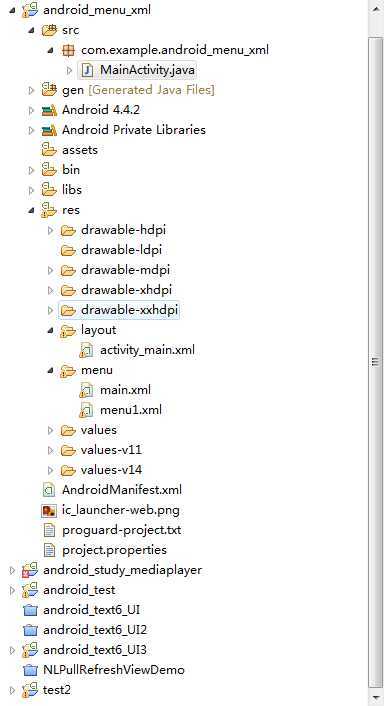标签:android style blog http color os

在android3.0中引入了menu菜单,通过menu的xml文件,我们能迅速新建生成一个菜单文件,接下来一一介绍几种常用的菜单。
1.menu的调用,重写两个方法即可实现
@Override public boolean onCreateOptionsMenu(Menu menu) { // TODO Auto-generated method stub getMenuInflater().inflate(R.menu.main, menu);//填充menu文件夹中的main.xml菜单layout return super.onCreateOptionsMenu(menu); } @Override public boolean onOptionsItemSelected(MenuItem item) {//对菜单的子项实现监控 // TODO Auto-generated method stub switch (item.getItemId()) { case R.id.add: Toast.makeText(MainActivity.this, "add", Toast.LENGTH_SHORT).show(); break; case R.id.edit: Toast.makeText(MainActivity.this, "edit", Toast.LENGTH_SHORT) .show(); break; case R.id.del: Toast.makeText(MainActivity.this, "del", Toast.LENGTH_SHORT).show(); break; } return super.onOptionsItemSelected(item); }
2.subMenu的用法,请看代码和注释
@Override public boolean onMenuItemSelected(int featureId, MenuItem item) {//重写onMenuItemSelected即可实现子选项的点击事件监控,本人在实验过程中,发现改变主题会使子选项失效 // TODO Auto-generated method stub switch (item.getItemId()) { case R.id.addall: Toast.makeText(MainActivity.this, "addall", Toast.LENGTH_SHORT) .show(); break; case R.id.addsomeone: Toast.makeText(MainActivity.this, "addsomeone", Toast.LENGTH_SHORT) .show(); break; } return super.onMenuItemSelected(featureId, item); }
3.popMenu的用法
在menu的xml中声明;
<RelativeLayout xmlns:android="http://schemas.android.com/apk/res/android" xmlns:tools="http://schemas.android.com/tools" android:layout_width="match_parent" android:layout_height="match_parent" tools:context="${packageName}.${activityClass}" > <!-- 在button中设置触发时的方法体 --> <Button android:id="@+id/button1" android:layout_width="wrap_content" android:layout_height="wrap_content" android:layout_alignParentTop="true" android:layout_marginLeft="22dp" android:layout_marginTop="45dp" android:onClick="showpopMenu" android:text="弹出菜单" /> <ListView android:id="@+id/listView1" android:layout_width="match_parent" android:layout_height="wrap_content" android:layout_alignParentLeft="true" android:layout_below="@+id/button1" > </ListView> </RelativeLayout>
在activity中实现方法体,即可实现弹窗效果
public void showpopMenu(View view) { PopupMenu popupMenu = new PopupMenu(context, view); popupMenu.getMenuInflater().inflate(R.menu.menu1, popupMenu.getMenu()); popupMenu.show(); }
3.contextMenu,重写两个方法,即可实现contextMenu效果
public class MainActivity extends Activity implements OnItemLongClickListener { private ListView lv; private ArrayAdapter<String> mArrayAdapter; public Context context = MainActivity.this; @Override protected void onCreate(Bundle savedInstanceState) { super.onCreate(savedInstanceState); setContentView(R.layout.activity_main); init(); lv.setAdapter(mArrayAdapter); registerForContextMenu(lv); } void init() { lv = (ListView) findViewById(R.id.listView1); mArrayAdapter = new ArrayAdapter<String>(context, android.R.layout.simple_list_item_1, getData()); } public void showpopMenu(View view) { PopupMenu popupMenu = new PopupMenu(context, view); popupMenu.getMenuInflater().inflate(R.menu.menu1, popupMenu.getMenu()); popupMenu.show(); } List<String> getData() { List<String> mlist = new ArrayList<String>(); for (int i = 0; i < 10; i++) { mlist.add("minfan" + i); } return mlist; } @Override public boolean onContextItemSelected(MenuItem item) { // TODO Auto-generated method stub AdapterContextMenuInfo info = (AdapterContextMenuInfo) item .getMenuInfo(); String value = mArrayAdapter.getItem(info.position);//value值表示的是listview中的item的信息,用于定位 switch (item.getItemId()) { case R.id.item1: Toast.makeText(context, "item1" + value, Toast.LENGTH_SHORT).show(); break; case R.id.item2: Toast.makeText(context, "item2" + value, Toast.LENGTH_SHORT).show(); break; case R.id.item3: Toast.makeText(context, "item3" + value, Toast.LENGTH_SHORT).show(); break; } return super.onContextItemSelected(item); } @Override public void onCreateContextMenu(android.view.ContextMenu menu, View v, android.view.ContextMenu.ContextMenuInfo menuInfo) { getMenuInflater().inflate(R.menu.menu1, menu); }; }
Menu,SubMenu,popupMenu,contextMenu的xml用法,布布扣,bubuko.com
Menu,SubMenu,popupMenu,contextMenu的xml用法
标签:android style blog http color os
原文地址:http://www.cnblogs.com/mf0819/p/3863341.html